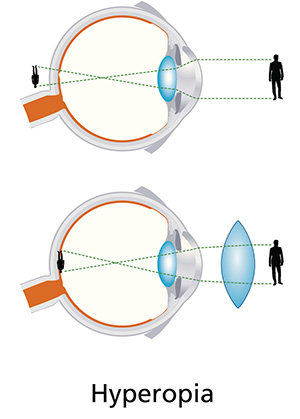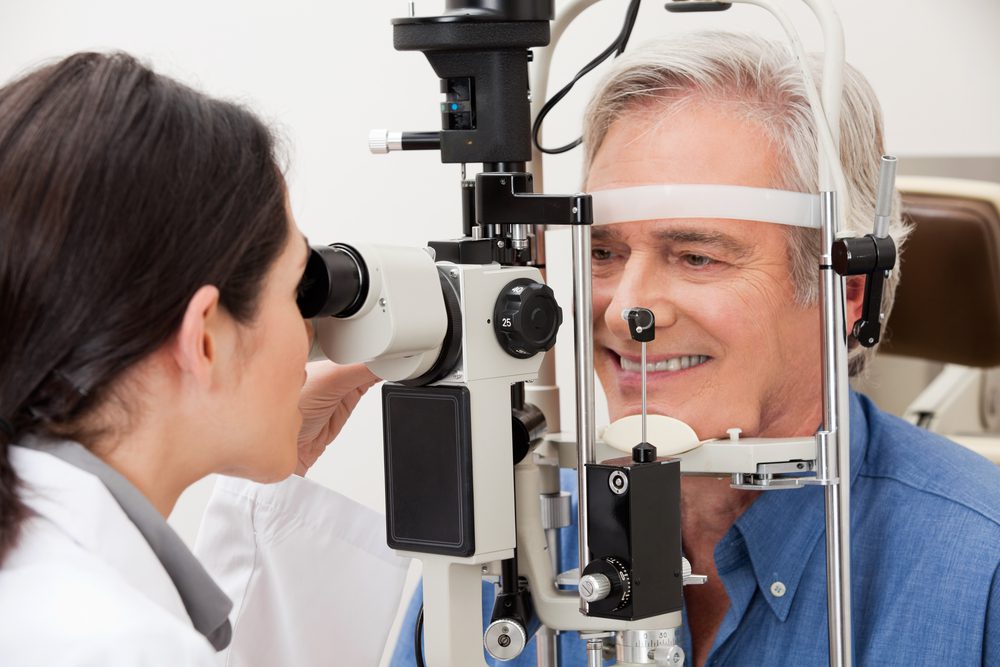What is hyperopia (Also called farsightedness)?
Hyperopia (hi-per-OH-pea-uh), or farsightedness, is a type of refractive error. Hyperopia is a vision condition in which near objects– such as books, menus, or a smartphone- appear blurred, but distant objects remain clear. Younger children can see clearly at near with hyperopia but as they age or get tired near objects can appear blurry. However, people with a high amount of hyperopia may have trouble seeing at all distances. Hyperopia can be:
- Low hyperopia is +2.00D or less
- Moderate hyperopia is from +2.25 to +5.00D,
- High hyperopia is +5.25D or more

In hyperopia, nearer objects focus behind the retina (top image), instead of on the retina (lower image). This causes blurred vision for nearer objects.
Why is hyperopia a problem?
- Without correction, you may have headaches and a dull pain in your eyes.
- Severe hyperopia may cause you to experience crossed eyes, amblyopia (lazy eye), and eyestrain.
What causes hyperopia?
Hyperopia is caused by:
- An eye that is too short from front to back of the eye to focus what you see on the back of the eye.
- A flaw in the shape of the cornea (clear part in the front of the eye) or the lens (clear part of the eye behind the pupil that brings light into focus on the back of the eye).
This results in the eye not focusing light on the back of your eye called the retina (the retina acts like the film in a camera to help us see) leading to blurred vision at close distances.
If you have family members with a history of hyperopia, you are more likely to also have hyperopia. If you have mild hyperopia, you may not experience any symptoms. Undergoing regular eye examinations will help you take charge of your vision health.
Hyperopia Diagnosis
An ophthalmologist (an eye doctor with a medical degree: MD or DO) or an optometrist (an eye doctor with an optometry degree: OD) will conduct a dilated eye examination to find out if you have hyperopia and determine what treatment is needed.
Your prescription may change over time, so it is important to have regular dilated eye exams and review treatment options based on your changing needs.
Hyperopia treatment
A few treatments are available for hyperopia. This may include eyeglasses, contact lenses, or other treatments to help you see clearly. Your eye doctor will work with you to identify the right treatment for your specific needs.
- Eyeglasses: Glasses for hyperopia act like a magnifying lens (thicker in the center) to focus light on the back of your eye correctly. Eyeglass prescription for hyperopia will be a positive number, with a larger number meaning a higher amount of hyperopia. It is important to communicate your specific vision needs to your eye doctor, since eyeglasses can be modified specifically for computer work, reading, hobbies, sports, or all-around needs.
- Contact lenses: Contact lenses also work by focusing light correctly on the back of your eye so that you can see more clearly but are worn directly on the surface of your eye. Contact lenses require a different prescription than a prescription for eyeglasses, and additional measurements of your eye.
- Refractive surgery: If you are a good candidate for surgery, your ophthalmologist or optometrist may recommend surgical reshaping of your cornea (clear part in the front of the eye). Your prescription may change over time, so it is important to have regular eye exams and review treatment options based on your changing needs.
